In this lab, we’ll analyze the malware found in the file Lab06-03.exe.
Questions and Short Answers
-
Compare the calls in main to Lab 6-2’s main method. What is the new function called from main?
A: The functions at 0x401000 and 0x401040 are the same as those in Lab 6-2. At 0x401271 is printf. The 0x401130 function is new to this lab.
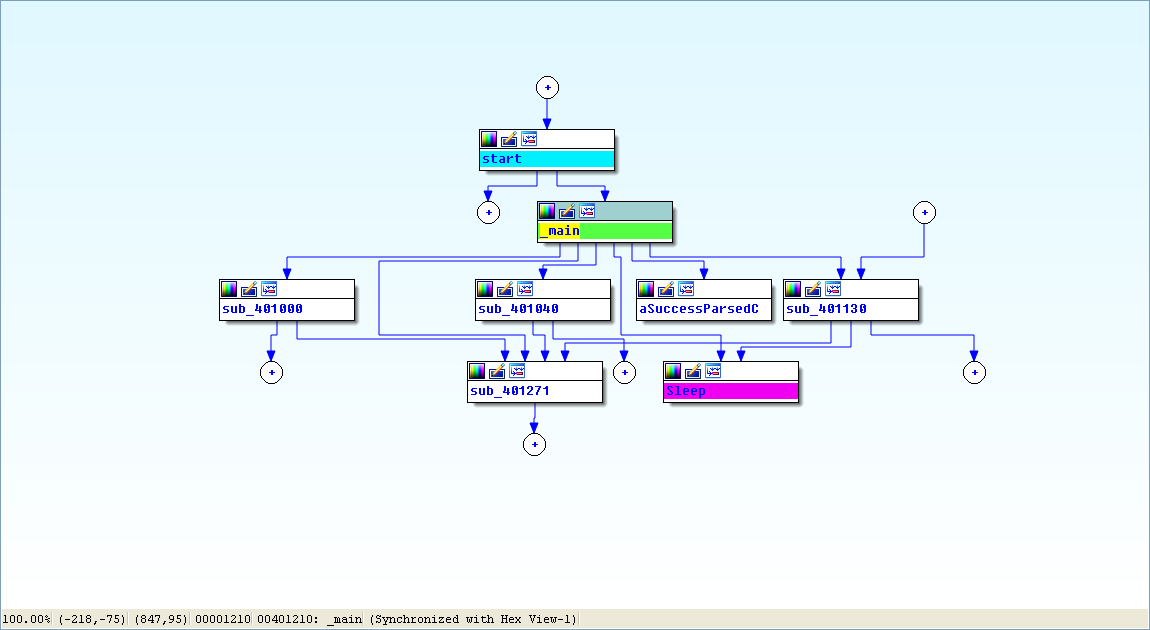
View -> Graphs -> Flow chart :
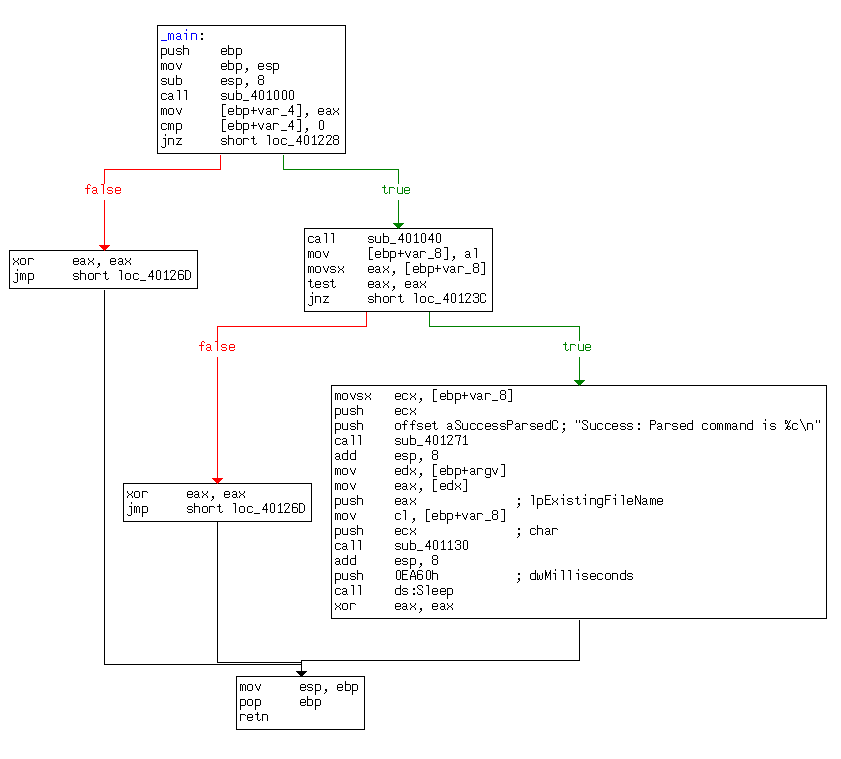
-
What parameters does this new function take?
A: The new function takes two parameters. The first is the command character parsed from the HTML comment, and the second is the program name argv[0], the standard main parameter.
-
What major code construct does this function contain?
A: The new function contains a switch statement with a jump table.
-
What can this function do?
A: The new function can print error messages, delete a file, create a directory, set a registry value, copy a file, or sleep for 100 seconds.
-
Are there any host-based indicators for this malware?
A: The registry key SoftwareMicrosoftWindowsCurrentVersionRunMalware
and the file location C:Tempcc.exe can both be host-based indicators. -
What is the purpose of this malware?
A: The program first checks for an active Internet connection. If no Internet connection is found, the program terminates. Otherwise, the program will attempt to download a web page containing an embedded HTML comment beginning with
<!--. The first character of the comment is parsed and used in a switch statement to determine which action to take on the local system, including whether to delete a file, create a directory, set a registry run key, copy a file, or sleep for 100 seconds.
Detailed Analysis
We begin by performing basic static analysis on the binary and find several new strings of interest, as shown in Listing 6-6L.

These error messages suggest that the program may be able to modify the registry. SoftwareMicrosoftWindowsCurrentVersionRun is a common auto-run location in the registry. C:Tempcc.exe is a directory and filename that may be useful as a host-based indicator.
Looking at the imports, we see several new Windows API functions not found in Lab 6-2, as shown in Listing 6-7L.
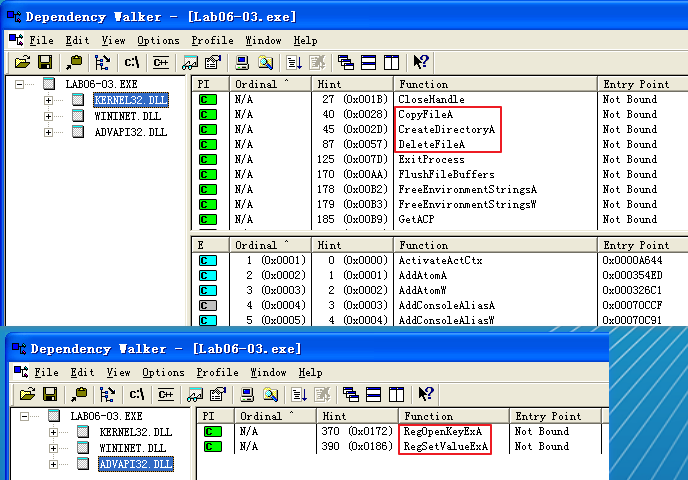
The first three imports are self-explanatory. The RegOpenKeyExA function is typically used with RegSetValueExA to insert information into the registry, usually when the malware sets itself or another program to start on system boot for the sake of persistence. (We discuss the Windows registry in depth in Chapter 7.)
Next, we perform dynamic analysis, but find that it isn’t very fruitful (not surprising based on what we discovered in Lab 6-2). We could connect the malware directly to the Internet or use INetSim to serve web pages to the malware, but we wouldn’t know what to put in the HTML comment. Therefore, we need to perform more in-depth analysis by looking at the disassembly.
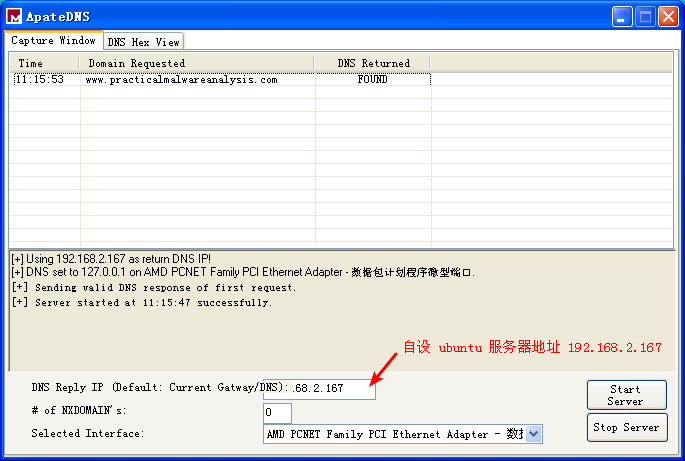
ApateDNS 点击 Stop Server,服务器 Ubuntu 端快捷键 control + c 结束服务。会产生日志文件,查看日志文件内容如下:
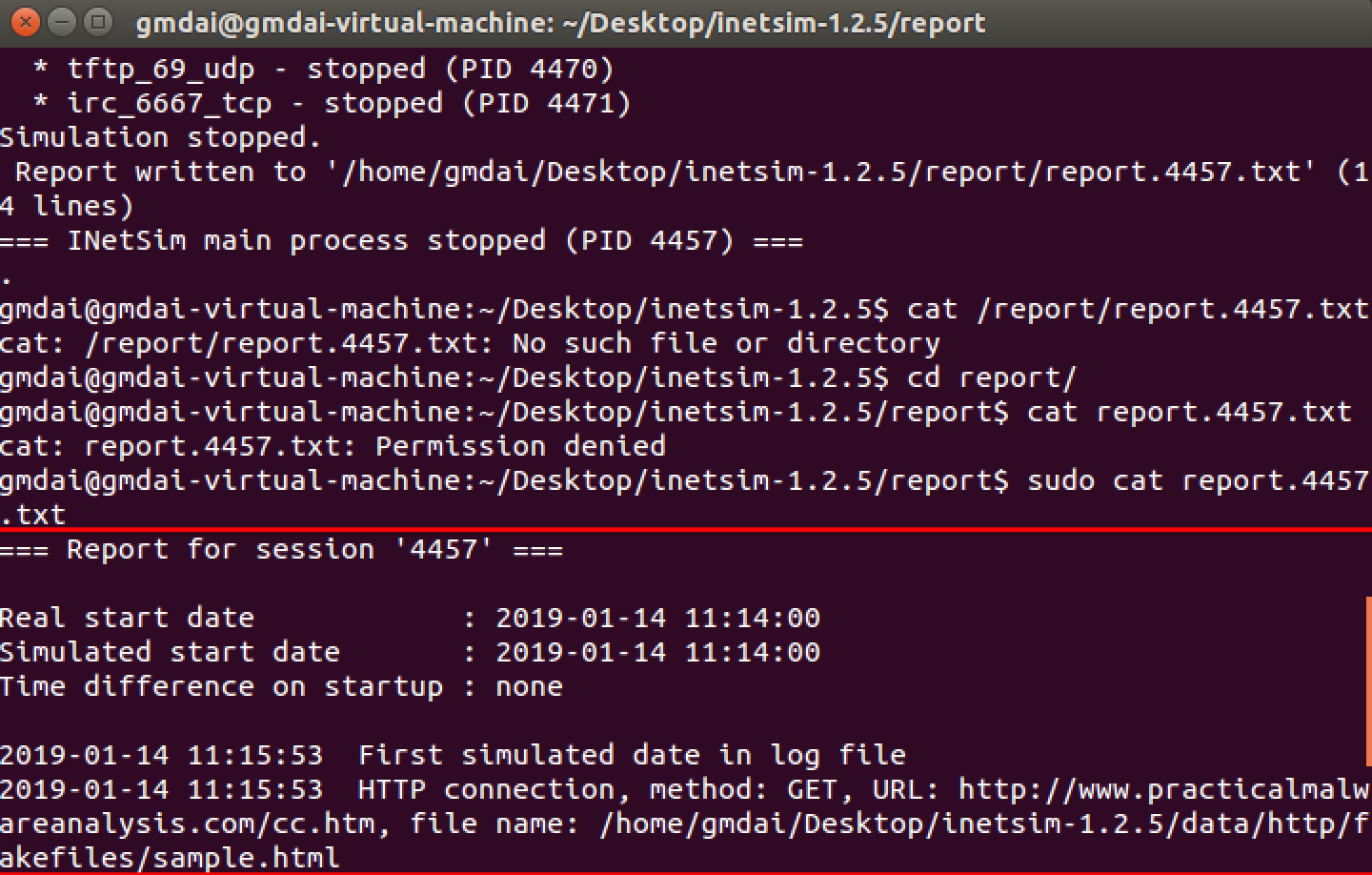
Finally, we load the executable into IDA Pro. The main method looks nearly identical to the one from Lab 6-2, except there is an extra call to 0x401130. The calls to 0x401000 (check Internet connection) and 0x401040 (download web page and parse HTML comment) are identical to those in Lab 6-2.
Next, we examine the parameters passed to 0x401130. It looks like argv and var_8 are pushed onto the stack before the call. In this case, argv is Argv[0], a reference to a string containing the current program’s name, Lab06-03.exe. Examining the disassembly, we see that var_8 is set to AL at 0x40122D. Remember that EAX is the return value from the previous function call, and that AL is contained within EAX. In this case, the previous function call is 0x401040 (download web page and parse HTML comment). Therefore, var_8 is passed to 0x401130 containing the command character parsed from the HTML comment.

Now that we know what is passed to the function at 0x401130, we can analyze it. Listing 6-8L is from the start of the function.

arg_0 is an automatic label from IDA Pro that lists the last parameter pushed before the call; therefore, arg_0 is the parsed command character retrieved from the Internet. The parsed command character is moved into var_8 and eventually loaded into ECX at ({color{red} 1}). The next instruction subtracts 0x61 (the letter a in ASCII) from ECX. Therefore, once this instruction executes, ECX will equal 0 when arg_0 is equal to a.
Next, a comparison to the number 4 at ({color{red} 2}) checks to see if the command character (arg_0) is a, b, c, d, or e. Any other result will force the ja instruction to leave this section of code. Otherwise, we see the parsed command character used as an index into the jump table at ({color{red} 3}).
The EDX is multiplied by 4 at ({color{red} 3 }) because the jump table is a set of memory addresses referencing the different possible paths, and each memory address is 4 bytes in size. The jump table at ({color{red} 4}) has five entries, as expected. A jump table like this is often used by a compiler when generating assembly for a switch statement, as described in Chapter 6.
Graphical View of Command Character Switch
Now let’s look at the graphical view of this function, as shown in Figure 6-3L. We see six possible paths through the code, including five cases and the default. The “jump above 4” instruction takes us down the default path; otherwise, the jump table causes an execution path of the a through e branches. When you see a graph like the one in the figure (a single box going to many different boxes), you should suspect a switch statement. You can confirm that suspicion by looking at the code logic and jump table.
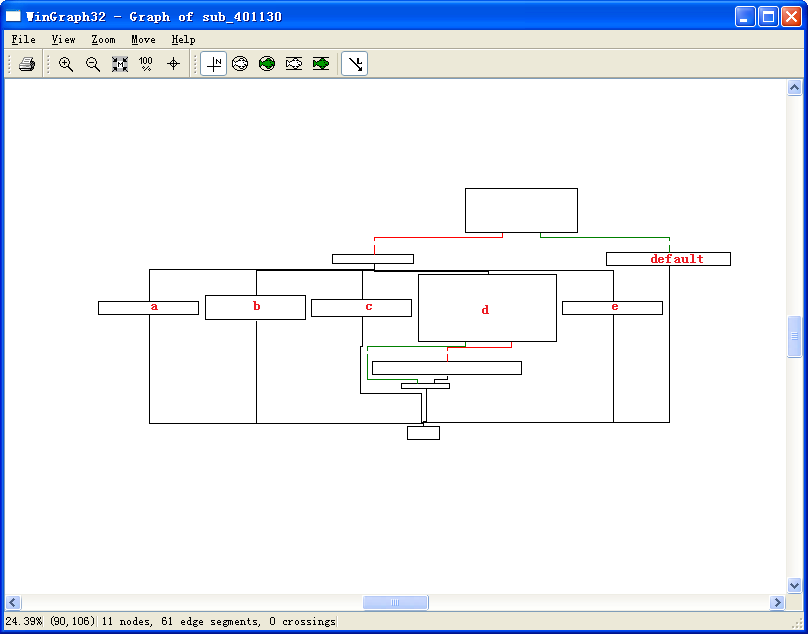
Switch Options
Next, we will examine each of the switch options (a through e) individually.
- The a option calls CreateDirectory with the parameter C:\Temp, to create the path if it doesn’t already exist.
- The b option calls CopyFile, which takes two parameters: a source and a destination file. The destination is C:\Temp\cc.exe. The source is a parameter passed to this function, which, based on our earlier analysis, we know to be the program name (Argv[0]). Therefore, this option would copy Lab06-03.exe to C:Tempcc.exe.
- The c option calls DeleteFile with the parameter C:\Temp\cc.exe, which deletes that file if it exists.
- The d option sets a value in the Windows registry for persistence. Specifically, it sets SoftwareMicrosoftWindowsCurrentVersionRunMalware to C:Tempcc.exe, which makes the malware start at system boot (if it is first copied to the Temp location).
- The e option sleeps for 100 seconds.
- Finally, the default option prints “Error 3.2: Not a valid command provided.”
Having analyzed this function fully, we can combine it with our analysis from Lab 6-2 to gain a strong understanding of how the overall program operates.
We now know that the program checks for an active Internet connection using the if construct. If there is no valid Internet connection, the program terminates. Otherwise, the program attempts to download a web page that contains an embedded HTML comment starting with <!--. The next character is parsed from this comment and used in a switch statement to determine which action to take on the local system: delete a file, create a directory, set a registry run key, copy a file, or sleep for 100 seconds.